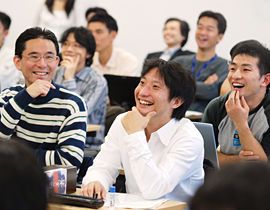Concept
What is system design and management?
A system is a collection of multiple elements that work together. ("The system loses its essential nature if the individual elements are separated. In some cases, improving the performance of a single component element will actually worsen the performance of the system as a whole. This, indeed, is quite common in modern society" -Russell Ackoff, leading systems theorist.) At the Graduate School of System Design and Management (Keio SDM), we consider systems to be much broader than just, for example, IT systems. They include such things as information, communications, media, hardware, services and even human beings, organizations, societies and the global environment.
The design of systems requires that all of the different, interrelated factors be balanced: the system's meaning, value, purpose, functions, dynamics, social environment and the global environment. What this specifically entails is both the creative architecture and design of the system and an evaluation of its feasibility. When we talk about "design" at Keio SDM, we are not referring merely to figurative design, but a broader idea that extends from the design of technology systems to "grand designs" like organizations, societies, businesses, and policies. We recommend both concepts and solutions for systems of all shapes and sizes.
 The "management" of systems involves the creative, consistent administration of the system's operations by formulating appropriate goals from diverse perspectives and taking account of all of the different factors involved, including environmental changes and human uncertainties.
The "management" of systems involves the creative, consistent administration of the system's operations by formulating appropriate goals from diverse perspectives and taking account of all of the different factors involved, including environmental changes and human uncertainties.
In other words, "system design and management" is an academic and professional discipline for the creative design and reliable management of all systems that are large, complex and contain elements of uncertainty, from technology systems all the way to conceptual recommendations for social systems. Our fundamental approach to systems engineering at Keio SDM is based on the V model, and that is where our education and research begins. We also provide systematic education and research on management, covering everything from project management to organizational theory.
What is systems engineering?
"An interdisciplinary approach and means to enable the realization of successful systems." (INCOSE Handbook, 2000) "Success" in this context is defined as satisfying requirements for quality within given cost and delivery parameters.
When we speak of a "systems engineer" (SE) in Japan, we usually think of an engineer that deals with computer systems and software. Indeed, it is common to confuse systems engineering with software engineering. Elsewhere in the world, however, "systems engineering" goes far beyond software and encompasses the engineering of all systems, including mechanical, architectural, civil and social. Obviously, at Keio SDM, we use the latter definition of "system."
What is the v-model of system design?
The "v-model" is a concept used in systems engineering to illustrate to the importance of practicing "decomposition and integration" and "design and verification/validation" in the design of systems. The left side of the "v" is decomposition; the right, integration. Large, complex systems can be decomposed into subsystems, sub-subsystems and all the way down to components. Once everything from the general structure to the details has been designed, the system is then integrated in the order required. The arrows moving from the left side to the right side of the "v" represent verification and validation at different levels of design.
In other words, it is crucial to evaluate the system at all levels, from the components to the system as a whole. At Keio SDM, we emphasize the need for requirement analysis and systems architecture at the start of the "v." This means defining all of the different requirements of all of the different stakeholders, including the global and social environments. Once that information is shared and the architecture for the overall system is in place, we use the v-model to decompose and integrate it, design and evaluate it.
What is design thinking
Generally, design thinking is the idea of designing creative, innovative technology systems and social systems with the same flexible attitude and approach that one would bring to artistic and industrial design. In design thinking, our goal is to collaborate as teams and use action learning to create new solutions. Design thinking at Keio SDM is more systematic than ordinary design thinking. Because we use the V model of system design to organize design thinking processes and techniques, students can learn systematic and innovative design thinking in accordance with the Keio SDM's academic disciplines. We first gain a thorough understanding of social needs, and then follow with creative brainstorming, rigorous validation and reliable management.
